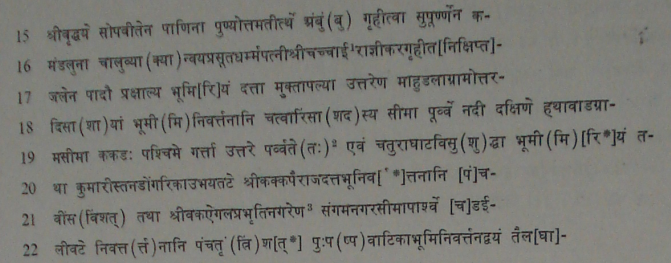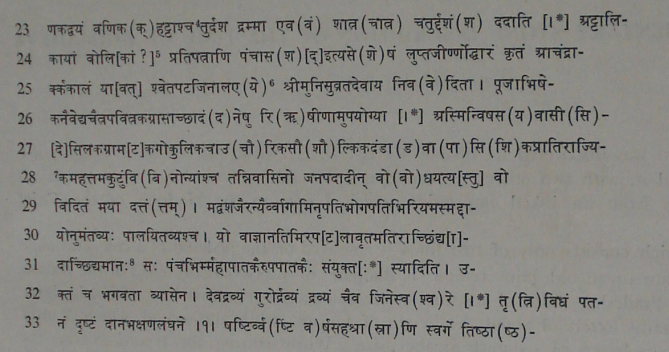| |
North
Indian Inscriptions |
| |
|
|
|
INSCRIPTIONS OF THE PARAMARAS OF MALWA
KĀLVAN PLATE INSCRIPTION OF THE TIME OF BHOJADEVA

Second Plate; Second Side

Third Plate

______________________________________________________________________________
[1] R.D.B. : चच्छाई.
[2] Above the first three of these letters there are redundant chisel strokes. The word ककड appears to have been
put here in the sense of कङ्कट.
[3] The editor of the inscription translated this expression as ‘Vakaaigala and others of the town’ ; but Barnett has
pointed out that nagara is a regular term in the south for ‘a commercial community’. See D.H.N.I., Vol. II, p.
864, n. 2. Also see p. 72, n. 1 of Ep. Ind., op. cit., where it is remarked that Yaśōvarman was a feudatory of
Bhōja. In this respect, also see Ep. Vol. XVIII, p.320, n.1.
[4] A sign for superscript र् was originally carved on this letter and subsequently scored as redundant. The mātrā
of the preceding ट्टा is crescent-shaped.
[5] The letters are damaged and the reading is uncertain.
[6] Banerji read Śvētapada and identified it with northern part of the Nāsik District. But the last akshara of
the name is definitely ṭa as taken here and also read by D.R. Bhandarkar, to which our attention has been
drawn by Prof. V.V. Mirashi in his C.I.I., Vol. IV, p. lxix, n 8, and p. 385, n. 4. Here the word means śvētāmbara
which also appears in 1. 10, above.
[7] This akshara is preceded by what looks like a snake. Dēsilaka used in this expression is perhaps in the sense
of dēsika, a local officer, or in that of dēśi (also found as dēsi) whih probably means the foreman of a guild, for
which see C.I.I., Vol. IV, p. 195, n. 6. Grāmaṭaka is probably used for grāmakūṭa, meaning a nobleman (in
the village). Gōkulika may have been the head of cowherds and Chaurika, one in charge of the grazing ground
was, as the meaning of the word suggests, an officer of the neighbouring kingdom.
[8] Better read श्र्पाच्छिन्दमानं वानुमोदेत.
[9] The punctuation marks is redundant, as same others below.
|
\D7
![]()
|










